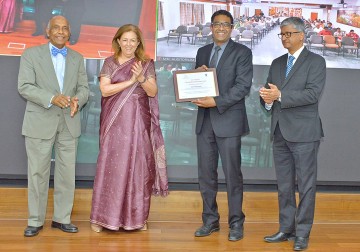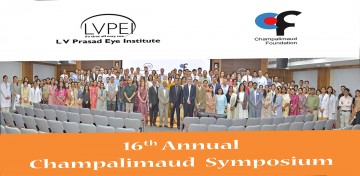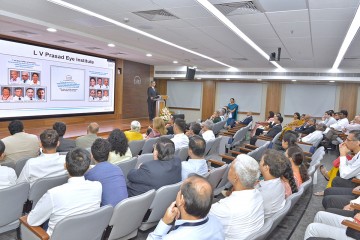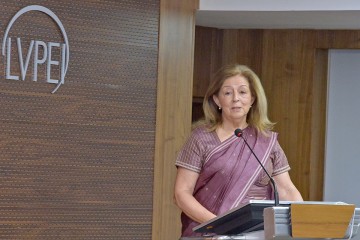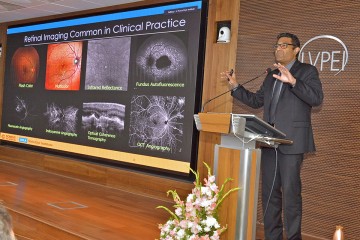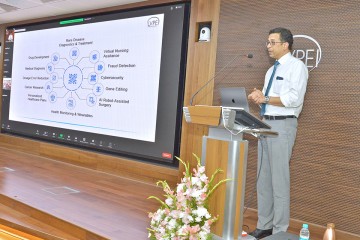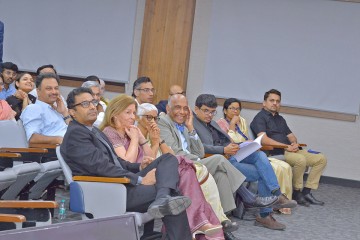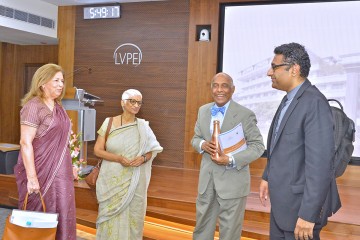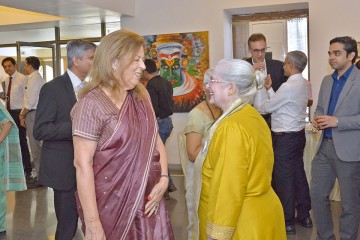Sunday, 4th February, marked the 16th annual Champalimaud symposium at the L V Prasad Eye Institute, bringing together invited presentations from across the LVPEI research effort and four keynote lectures through the day.
Dr Prashant Garg, Executive Chair, and Dr Gullapalli N Rao, Founder Chair, opened the symposium, inviting all the speakers to present their work. Dr Rao noted that the hallmark of LVPEI—and what makes it more than a ‘hospital’, and indeed, an ‘institute’—is the creation, dissemination, and practice of new knowledge. Dr Sayan Basu, the Prof. D Balasubramanian Chair of Eye Research at LVPEI, highlighted the key research priorities and outcomes at LVPEI. He showcased the wide range of research publications that are produced by many people at LVPEI. He also noted the key themes that power research process at LVPEI: A ‘patient-first’ focus, excellence, equitable, driven with integrity, and most important, ‘togetherness’. A key reason for LVPEI’s research success are the multidisciplinary research teams that work across cross-cutting expertise to improve patient outcomes.
Ms Leonor Beleza, President of the Board of Directors of the Champalimaud Foundation, spoke fondly and with many pictures from the past about the long collaboration between LVPEI and the Foundation. She also showcased some of the key research work that is driving interest at the Foundation, primarily around the use of Zebra fish to narrow down treatment modalities for patients with cancer. She spoke about their efforts to personalise tests to match therapy with patient that reduces health care costs and needless suffering for the patients, particularly for those with colorectal and breast cancers. Ms Beleza also showcased the futuristic and clean-energy driven care offered at The Botton-Champalimaud Pancreatic Cancer Centre. She noted how LVPEI’s experience and practice of utilising donations influenced the Champalimaud Foundation’s approach for setting up this 50 million Euro centre.
Dr SriniVas R Sadda delivered the Annual Champalimaud Oration, on the future of retinal imaging. Dr Sadda is the Director of Artificial Intelligence & Imaging at Research Doheny Eye Institute and Professor of Ophthalmology at the University of California – Los Angeles (UCLA), USA. His lecture focused on technologies on the cusp of transitioning to the market and had a real opportunity to transform retinal practice. Talking across two axes, better resolution and more contrast, he noted the significant improvements in transverse resolution and axial resolution that were becoming available due to adaptive optics OCT. The improvements in contrast, he noted, included confocal imaging and hyperspectral imaging along with other advances that allowed a specialist to gain better understanding of subtle changes in the various sub-retinal layers. Finally, he discussed the promise of automation and AI to transform our ability to process images, diagnose disease, and even collaborate with other specialists, like those tackling neurological disease.
Keynote lectures
The symposia hosted four keynote lectures by research luminaries from India and the USA.
Dr Sanjeev Khosla, Director of CSIR-Institute of Microbial Technology, Chandigarh, India, explored microbial pathogenesis due to epigenetic interactions between the host and microbe. He noted the fascinating fact that proteins from two organisms in interaction ended up modulating each other through methylation and histone-binding. This has potential implications for developing treatment modalities in the future. Prof. Ullas Kolthur Seetharam, Tata Institute of Fundamental Research, Mumbai, India, presented the integration of genomics and energetics to better understand daily living activities. He noted the impact of malnutrition—deficient or excess intake of nutrition that can be seen even in high-income settings—in triggering metabolic changes in the body. Prof. L S Shashidhara, Director of the National Centre for Biological Sciences (NCBS), Pune, India, shared insights into novel molecular diagnostics in cancers. Prof. Purnanada Guptasarma, Dean of Faculty at the Indian Institute of Science Education and Research, Mohali, India, captivated the audience with 7 stories on the complexities of protein-hormone-mineral interactions that can have surprisingly positive or negative impact on our health.
LVPEI Research highlights
This symposium included key research areas from LVPEI including the ocular surface anatomy, treatment and regeneration/replacement; infections and pharmacology; optometry, rehabilitation and public health; ocular oncology and genetic priors of ocular diseases; and deploying AI and other innovation to eye care.
Dr Swati Singh showcased cutting-edge 7T MRI images and cinematic rendering of the lacrimal gland. Dr Sanchita Roy celebrated the launch of a dedicated centre for ocular pharmacological research at LVPEI. Dr Pavan Verkicherla and others showcased key areas of focus for research optometry and public health. Dr Beula Christy showcased LVPEI’s unique success with vision rehabilitation, while Drs Vishal Raval and Indrajeet Kaur discussed key research priorities in tackling ocular cancers and the possibilities of understanding genetic and protein signatures of eye diseases. Dr Kaur also discussed the possibility of using cytokines in tears to biomark retinopathy of prematurity in preterm babies.



